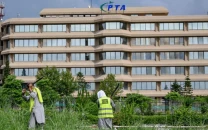Of children and their labour
Children in Pakistan work as street vendors, shoe polishers, rag-pickers & car washers to earn measly amounts of cash

The writer holds a PhD from the University of Melbourne and is the author of Development, Poverty and Power in Pakistan, available from Routledge
Common sense as well as a plethora of empirical data indicates that the chances of finding decent work opportunities during youth and adult life are extremely difficult when children have to work instead of going to school. Unfortunately, however, children of varying ages continue to labour in Pakistan across a wide range of sectors. The last National Child Labour Survey was conducted nearly 20 years ago (in 1996), which estimated that there were 3.3 million child labourers. The most recent International Labour Organisation (ILO) estimates released earlier this year, based on Pakistan’s Labour Force Survey 2010-11, indicated that 5.7 million 10-17-year-olds, representing nearly 20 per cent of all children in this age group within the country, were working.
These figures are considered conservative according to child rights activists, who point out that in the last four or five years, even more children have been pushed into the workforce by desperate families whose livelihoods have been destroyed by recurrent floods, and due to the dislocation caused by the ongoing conflict in our tribal areas.
Yet, it is important to pay attention to the breakdown of the available statistical data to understand specific aspects of the child labour phenomenon. A majority (more than two-thirds) of children working in Pakistan are engaged in the agricultural sector. It is also significant to note that around 68 per cent of employed children do not get paid as they are involved in family work. In rural areas, for instance, children work long hours toiling in the fields, including girls, who take on a disproportionate share of farm work such as cotton-picking or weeding, taking care of livestock, as well as other domestic work responsibilities, such as fetching water. Many of these children do not go to school or drop out in order to do this work without any remuneration.
Only around 32 per cent of child labourers are being paid wages or are self-employed according to the available estimates. Self-employed children work as street vendors, shoe polishers, rag-pickers and car washers, in order to earn measly amounts of cash. Lowly paid children are commonly employed in informal settings, such as hotels, restaurants and shops, which are outside the scope of labour inspections. Child labour has also been found in many manufacturing processes associated with leather, football and surgical instruments production, as well as sea food processing. Children even work in hazardous environments, such as brick kilns and coal mines. The ILO’s World Report on Child Labour for 2015 found that Pakistan has the second highest number of adolescents (1.3 million) employed in hazardous industries.
Besides poverty, unsustainable household sizes, the lack of adequate opportunities for older family member and the prevalent societal tolerance for child labour exacerbate this problem. The Punjab government has been drafting a bill, which proposes harsher penalties including not only higher fines, but also jail time for owners of businesses caught employing children under the age of 14. This new bill also seeks prohibition of employment of adolescents aged between 14 and 18 in hazardous tasks and recommends better work conditions for them. The cabinet committee should also pay heed to the advice of child rights groups, which are advocating that the minimum employment age for working children be raised from 14 to 16 years. Moreover, other provinces also need to follow suit with formulation of stricter legislation to curb child labour, as well as to address the implementation gaps that enable existing child labour laws to be easily contravened. Much more attention needs to be paid to the informal sector in particular, where a bulk of child labour seems to be concentrated. Unless a more comprehensive approach to addressing this serious problem can be put into effect, a significant proportion of our youth population will never be able to reach its productive potential.
Published in The Express Tribune, December 11th, 2015.
Like Opinion & Editorial on Facebook, follow @ETOpEd on Twitter to receive all updates on all our daily pieces.












COMMENTS
Comments are moderated and generally will be posted if they are on-topic and not abusive.
For more information, please see our Comments FAQ